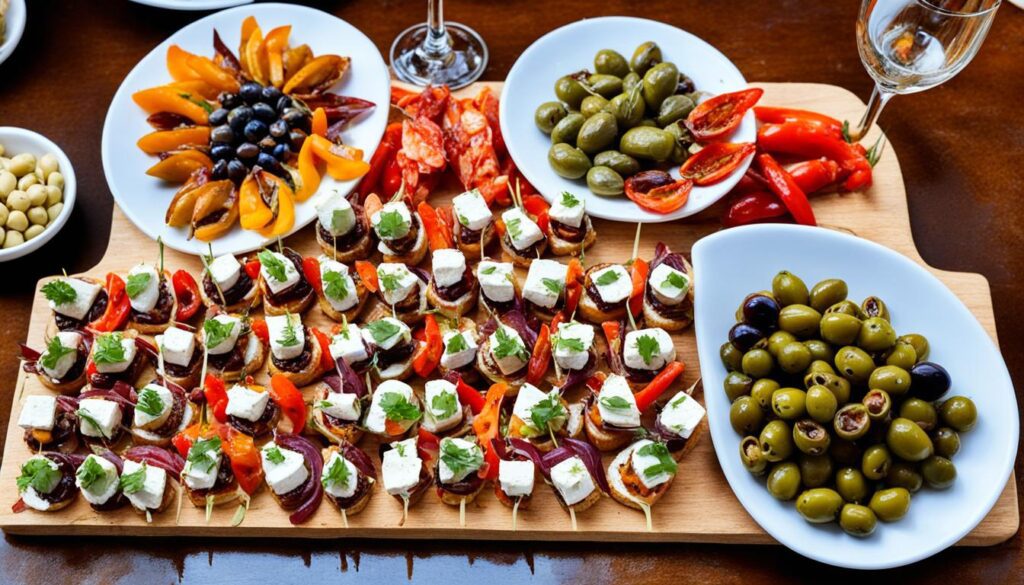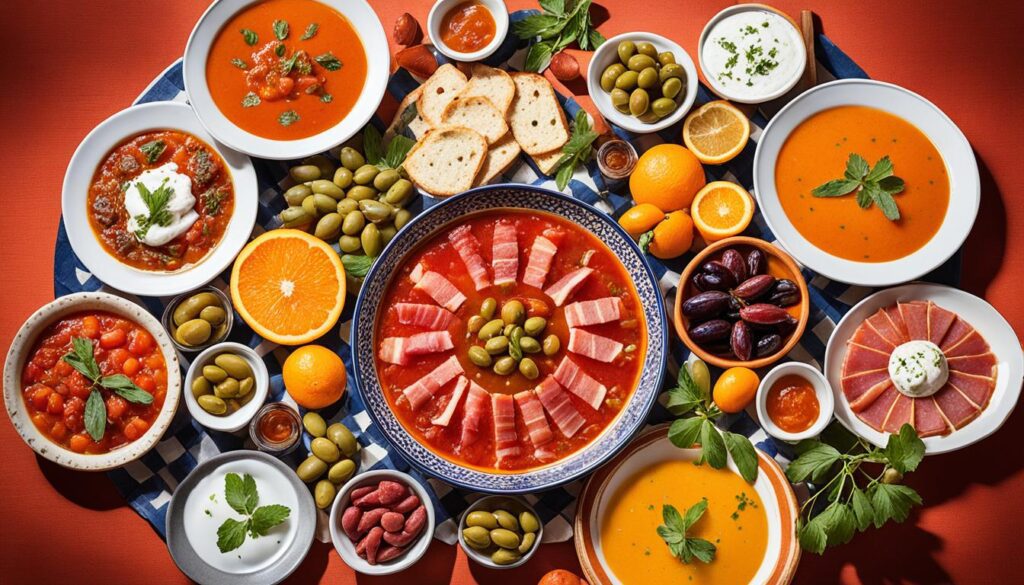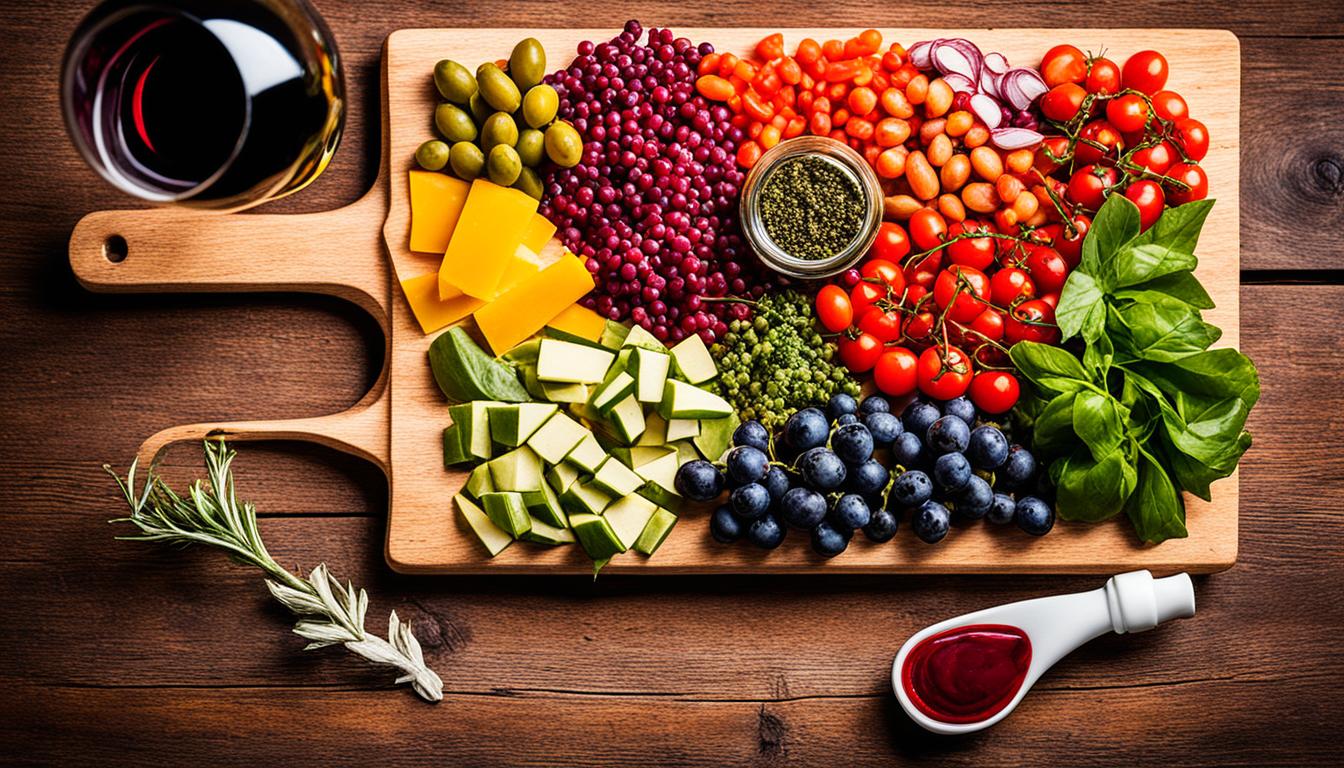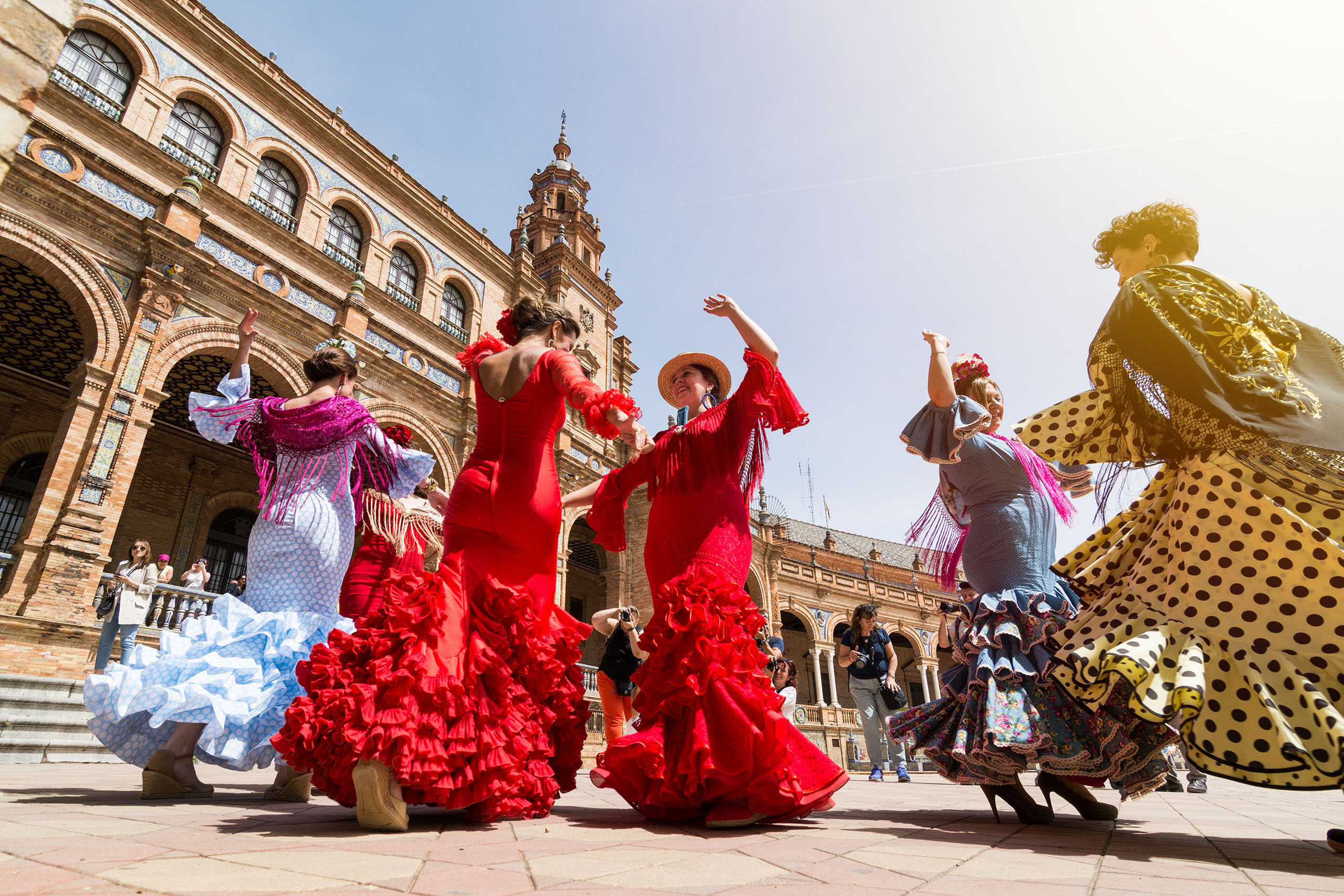For centuries, Spain’s cuisine has been filled with tradition. You can enjoy pintxos in Basque Country, taste amazing wines on the Empordá wine route, and try Moorish and Mediterranean dishes in Catalonia. Don’t forget to taste the sherry of Andalusia. Join a food and wine tour to explore Spain’s diverse culinary world.
Key Takeaways
- Explore the diverse regional cuisines and wine regions of Spain
- Indulge in traditional tapas, pintxos, and Moorish-inspired dishes
- Discover the renowned wine-producing areas like La Rioja and Ribera del Duero
- Savor the Basque Country’s avant-garde culinary scene and Catalan specialties
- Engage with local chefs and artisans to learn about Spanish culinary traditions
Unraveling the Culinary Tapestry of Spain
Spain’s cuisine is a rich mix of flavors and traditions from different regions. From Barcelona’s cava and Catalan dishes to Andalusia’s sherry and Moorish flavors, each area has its own taste. Let’s explore the traditional ways and local ingredients that have made Spanish gastronomy what it is today. This gives us a peek into the heart of this fascinating country.
Exploring the Diverse Flavors of the Regions
Spain is a big name in food, with 13% of the world’s vineyards and 75% of the global saffron. Spanish cuisine is known for its wide range of tastes, from famous dishes like paella and tortilla de patatas to the well-known jamón ibérico and gambas al ajillo. You’ll find regional dishes like pulpo a la gallega and calamares a la romana, showing the coastal influence and seafood richness of Spanish culinary traditions.
Traditional Techniques and Ingredients
- Olive oil is key in Spanish cuisine, used a lot in sauces and dressings.
- Herbs like parsley, oregano, rosemary, and thyme add flavor to Spanish dishes.
- Garlic is a big part of Spanish gastronomy, giving dishes a unique taste.
- Chicken, pork, lamb, and veal are common meats in Spanish food culture.
- Fish and seafood are big in Spanish cuisine, showing the country’s coastal impact.
The Spanish cuisine has been shaped over centuries by many cultures, including Roman, Greek, Moorish, and Jewish. From the famous paella to the loved tapas and pinchos, Spain’s food culture still charms and delights people all over the world.
“Spanish cuisine is a culinary treasure trove, offering a harmonious blend of rich regional flavors and time-honored techniques that have been passed down through generations.”
Barcelona: Tapas and Cava Delights
Barcelona, the vibrant capital of Catalonia, is a paradise for tapas lovers. Walk through the lively areas and try different small plates. These dishes reflect the region’s Moorish and Mediterranean tastes. Enjoy these tasty spanish tapas with spanish cava, a bubbly wine perfect for catalan food and celebrations.
Explore the barcelona cuisine as you follow the tapas trails. You’ll find everything from classic patatas bravas to delicious jamon iberico. These dishes show off the culinary skills of the Catalan people. Don’t miss La Pineda Xarcuteria for a wide variety of tapas and wines, including spanish cava.
Trying pintxos, a type of tapas on a stick, is a must in Barcelona. These small bites let you taste different flavors, like chorizo and fuet. Enjoy the fun atmosphere of the city’s tapas bars. The sounds of chatting and glasses clinking make it a place of culinary joy.
| Experience | Average Price |
|---|---|
| Glass of Cava at El Xampanyet | €2.50 |
| Rose Wine at Placa Reial Restaurants | 7 euros per litre |
| Menu del Dia at Attic Rooftop Restaurant | 16 euros |
| Cava Cocktails at Ginger | 5-6 euros |
| Drinks at Rita Blue Bar in El Raval | Varies |
| Glass of Wine at 360 Bar, Barcelo Raval | 5-6 euros |
Go on a tapas and spanish cava tour to dive deep into Barcelona’s food culture. With the help of local guides, you’ll find hidden spots, learn about the city’s history, and taste the flavors that make barcelona cuisine famous worldwide.
“The tapas tour was the highlight of our trip to Barcelona. Our guide, Esther, was exceptional, sharing fascinating insights into the city’s culinary traditions and guiding us to some truly remarkable spots. We left feeling more connected to the catalan food culture than we ever imagined possible.”
La Rioja: The Heartland of Spanish Wines
Explore the heart of Spain’s famous wine country, La Rioja. This area is known for its beautiful vineyards on rolling hills. It has a small population of around 316,000 people, but it’s a giant in wine production.
Exploring the Legendary Vineyards
La Rioja is home to over 500 wineries across 54,000 hectares. Most of its vineyards grow red grapes, making up 91% of the land. The star grape here is the tempranillo, which grows well in La Rioja’s varied soil and climate.
Tasting the Tempranillo Treasures
The wines from La Rioja are full-bodied and bold. They come from three main areas: Rioja Alta, Rioja Alavesa, and Rioja Oriental. Each area has its own unique taste, making La Rioja’s wines stand out.
The tempranillo grapes are the highlight here. They create wines that show off La Rioja’s winemaking skills and the hard work of its vineyards.
“The wines of La Rioja are a testament to the harmonious blend of tradition and innovation, where the essence of the land is expertly captured in every bottle.”
For wine lovers and travelers, visiting La Rioja is a must. It lets you dive into the rich wine culture and learn about the secrets behind these famous wines.
San Sebastian: The Pinxtos Capital
San Sebastian sits on the stunning Basque Country coast. It’s known as the heart of spanish pinxtos. These are small, tasty dishes loved by food lovers all over the world. As you walk through the old town, try different pintxos in each bar. You’ll get to know the amazing basque country cuisine.
The san sebastian food scene is all about these small dishes. You can try the famous Gilda pintxo, named after Rita Hayworth from the 1940s movie. Or, enjoy the salty taste of Cantabrian anchovies with Manzanilla olives and Guindilla peppers. For something richer, there’s seared foie gras on a fresh baguette.
“In San Sebastián, snacking is a way of life, and pintxos are the stars of the show.” – Renowned Food Critic, Jane Doe
It’s not just about the food in San Sebastian. You’ll also enjoy txakoli (a crisp Basque white wine) or sidra (Basque cider). The tradition of pintxo hopping is key to the san sebastian food scene. People move from bar to bar, trying different pintxos.
San Sebastian boasts an impressive 16 Michelin-starred restaurants in a city of just 200,000 people. Whether you like traditional seafood pintxos or new, creative ones, the city’s flavors will make you want to come back.

Madrid: A Gastronomic Epicenter
Madrid, the capital of Spain, is a hub for food lovers. It mixes its deep culture with a modern food scene. Dive into the lively tapas culture. Explore the busy bars and try the many small plates that are key to Spanish cuisine. Learn about the famous dishes and traditions that make Madrid a top spot for food lovers.
Discovering the Tapas Trail
Madrid’s tapas culture is a feast for the senses. Walk through the beautiful neighborhoods, stopping at bars and taverns for tasty bites. You’ll find everything from classic Spanish dishes to new creations. Each tapas spot gives you a peek into Madrid’s exciting madrid food scene.
Iconic Dishes and Culinary Traditions
Madrid is famous for its spanish culinary traditions. Old restaurants and taverns here focus on quality and excellence. Try the famous roast suckling pig or the rich Madrid stew, passed down through generations. These dishes still amaze both locals and visitors.
“Spain’s gastronomy has gained international recognition, with Michelin awards given to four restaurants with three rosettes, marking Spain as a hub of culinary excellence.”
| Restaurant | Neighborhood | Cuisine |
|---|---|---|
| Sala de Despiece | Madrid | Seafood |
| DSTAgE by Diego Guerrero | Madrid | Avant-garde |
| Noi | Malasaña | Italian |
| TOKI | Malasaña | Japanese |
| La Perejila | La Latina | Andalusian Tapas |
| Corral de la Morería | La Latina | Tapas and Flamenco |
| La Taberna de El Pimiento Verde | Centro | Basque Cuisine |
Andalusia: Sherry and Moorish Influences
Andalusia, in southern Spain, is a place where Moorish and Mediterranean flavors blend beautifully. It’s known for its sherry wines and dishes full of spices. This region is a paradise for those who love food and wine.
Andalusian food is famous for gazpacho and fried fish, also called pescaíto frito. These dishes show the mix of Christian, Muslim, and Jewish traditions. Olive oil from places like Jaén, Córdoba, Seville, and Granada is a big part of their cooking. It made up over 40% of Spain’s olive oil in the 19th century.
Being near the Atlantic and the Mediterranean means Andalusians eat a lot of fish and shellfish. They enjoy white shrimp, prawns, murex, and anchovies. Tuna, especially during its Atlantic migration, is used in dishes like atún encebollado.
The Moors brought sugar to Andalusia in the 10th century, which led to sweet Arabic desserts. But Andalusia is also famous for its wines, like sherry and manzanilla from Jerez. Other wines, such as paxarete, Montilla-Moriles, and Málaga wines, are also popular.
Some of the top dishes from Andalusia are jamón ibérico, gazpacho, salmorejo, and different types of sherry. The mix of Moorish and Mediterranean tastes makes Andalusia a place worth visiting for food lovers.

| Dish | Description |
|---|---|
| Gazpacho | A chilled tomato-based soup with Moorish influences |
| Fried Fish (Pescaíto Frito) | A traditional Andalusian dish of fried, small white fish |
| Atún Encebollado | A dish featuring tuna cooked with onions, a staple in Andalusia |
| Jamón Ibérico | The renowned cured Iberian ham, a signature of Andalusian cuisine |
| Salmorejo | A creamy, chilled soup made with tomatoes, bread, and olive oil |
food and wine in spain
Spain’s food and wine culture is full of rich traditions and regional diversity. It’s a place where every meal is a celebration of taste and culture. From the sunny vineyards of La Rioja to the bustling tapas bars of Barcelona, there’s a culinary journey waiting for you.
Try the Spanish cuisine, a mix of Moorish, Mediterranean, and local flavors. Enjoy the taste of Iberian ham, the spicy pimientos del padrón, and creamy cheeses from Asturias. Don’t miss the variety of tapas dishes that feature the versatile olive.
Explore Spain’s famous wine regions, like La Rioja, where you’ll find world-class Tempranillo reds. The Basque Country is known for its refreshing Txakoli white wine. And in Andalusia, you can learn about the art of making sherry in its historic bodegas.
Join in the fun at Spain’s lively food festivals, like the San Sebastián Gastronomika and the Tomatina in Buñol. Discover the traditional cooking methods and ingredients that make each region unique. From Galicia’s seafood dishes to Valencia’s saffron paellas, there’s a lot to explore.
Whether you’re enjoying cava in Barcelona, trying pintxos in San Sebastián, or visiting sherry houses in Jerez, Spain’s food and wine will capture your heart. Dive into the culinary traditions passed down through generations. Let the flavors of Spanish gastronomy take you on an unforgettable journey.
| Signature Spanish Ingredients | Culinary Traditions |
|---|---|
|
|
“Spain and Portugal are described as wine wonderlands with a diversity of grapes and terroirs. There is a return to winemaking roots in Spain and Portugal with indigenous varieties being recuperated alongside traditional winemaking methods.”
Step into the world of food and wine in Spain and discover a culture that’s as rich as its flavors. This journey will take you deep into the heart of Spanish gastronomy and the art of making Spanish wine regions.
Basque Country: Pintxos and Txakoli
The Basque Country lies along Spain’s rugged northern coast, a paradise for food and wine lovers. Here, you can enjoy the region’s famous pintxos. These are small, tasty snacks that highlight the sea’s gifts and local cooking traditions. Visitors can try about 12 top pintxos, ranging from classic Basque dishes to modern creations.
Savoring the Coastal Delicacies
Pintxos come with toothpicks to hold their ingredients together. There are thousands to try. You’ll find the Gilda pintxo, with spicy-sweet peppers, salty anchovies, and juicy olives. Another favorite is the squid-ink dish, Txipirones en su tinta.
There are over 1,000 pintxos inspired by fresh or marinated anchovies, known as boquerones. These snacks are a true treat from the Basque coast.
The Art of Pintxo Hopping
Start a pintxo-hopping journey to enjoy unique tastes and the lively atmosphere. Pair these snacks with txakoli, a crisp, aromatic white wine. This wine is perfect with Basque snacks.
Immerse yourself in Basque culture. Pintxos are small, meant to be eaten in one or two bites. Prices can vary, sometimes based on the number of toothpicks or pintxos you have.

